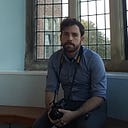O Holy Night — An Atheist, an American Christian, a Missing Hand, and War
Adolphe Adam — 1847
All Christmas music can be plotted along a spectrum. On the one end, we have “religious reverence and Christian service to God”, and “winter-related nonsense” on the other. If “Baby It’s Cold Outside” and “Jingle Bells” sit on the “Winter-Related Nonsense” end, “O Holy Night” pretty much sits exactly opposite it. This carol has been a staple in churches and holiday films for decades, and its notoriety is well deserved. The song is epic, like the Lord of the Rings in carol form, with huge, swelling chords climbing to peaceful resolve. It’s glorious, yet serene, with just a little darkness mixed in.
“O Holy Night” is the product of circumstance in southern France. In the medieval town of Requemaure in 1843, the parish priest of the local church wanted to commemorate the renovations to the church organ. This led him to poet and wine merchant Placide Cappeau, a man with little to no interest in religion. Cappeau accepted the request, and on a stagecoach en route to Paris, penned the poem “Minuit, chrétiens,” or “Midnight, christians.” Totally unrelated to the poem, but Cappeau had one hand, having lost his right hand as a child when his friend accidentally shot him. Impress your friends and family next time “O Holy Night” drops.
The priest suggested Cappeau bring his poem to Composer Adolphe Adam. Adam was actually a friend of Cappeau (not the one that shot him), and used the poem as the basis for a composition.
Adam was a prolific composer, writing music for several operas and ballets including Giselle, and can be placed on the lengthy list of Jewish composers who’ve written Christmas music. The resulting carol was simply titled “Cantique de Noël” or “Christmas Carol,” and premiered in 1847, performed by local opera singer Emily Laurey.
The carol was instantly popular, but took a sharp nosedive once word got out about Cappeau. Cappeau was an atheist with strong disdain for religious authority. Outraged, the church leadership banned the song from the French liturgy. The French people wouldn’t let the song go, and for a time it lived on outside the church. Eventually, this tune reached the ears of John Sullivan Dwight, an American Unitarian Minister, influential music critic, and part-time Santa impersonator.
In 1855, Dwight decided to translate it to English, and the resulting translation is what we now know as “O Holy Night.” Due to his more religious philosophies, Dwight decided to take a few liberties with Cappeau’s lyrics, and “O Holy Night” is much less subdued by comparison. Dwight changed Cappeau’s refrain “People, kneel down, await your deliverance. Christmas, Christmas, here is the Redeemer” to “O night divine, the night when Christ was born.” Dwight was a Transcendentalist, essentially a reactionary movement to Intellectualism that states there is an inherent goodness to everything and everyone. “O Holy Night” presents the night and the event itself as being holy, an element absent from the original. This version became popular, overshadowing the original, and with a few tweaks here and there over the last hundred and sixty-odd years, we have the modern version.
There is one more little oddity with this story. Legend has it that “Cantique de Noël” played a part in the Franco-Prussian War. During a lull in battle on December 24th, 1870, French troops started singing the carol from their trench, and it moved the German soldiers so much, they began to sing one of Martin Luther’s hymns. The impromptu battle of the bands resulted in a 24-hour truce so the soldiers on both sides could celebrate Christmas. There isn’t much proof that this actually happened, but it may have lead to the growth in popularity of the tune across France at the time and its eventual reinstatement into French churches.
So that’s “O Holy Night,” a song written by a Jewish man, based on a poem by a French atheist, rejected by the church, translated by an American Transcendentalist, maybe sung on battlefields with German troops, and most certainly sung every year by more and more singers who don’t give a damn about any of this.
